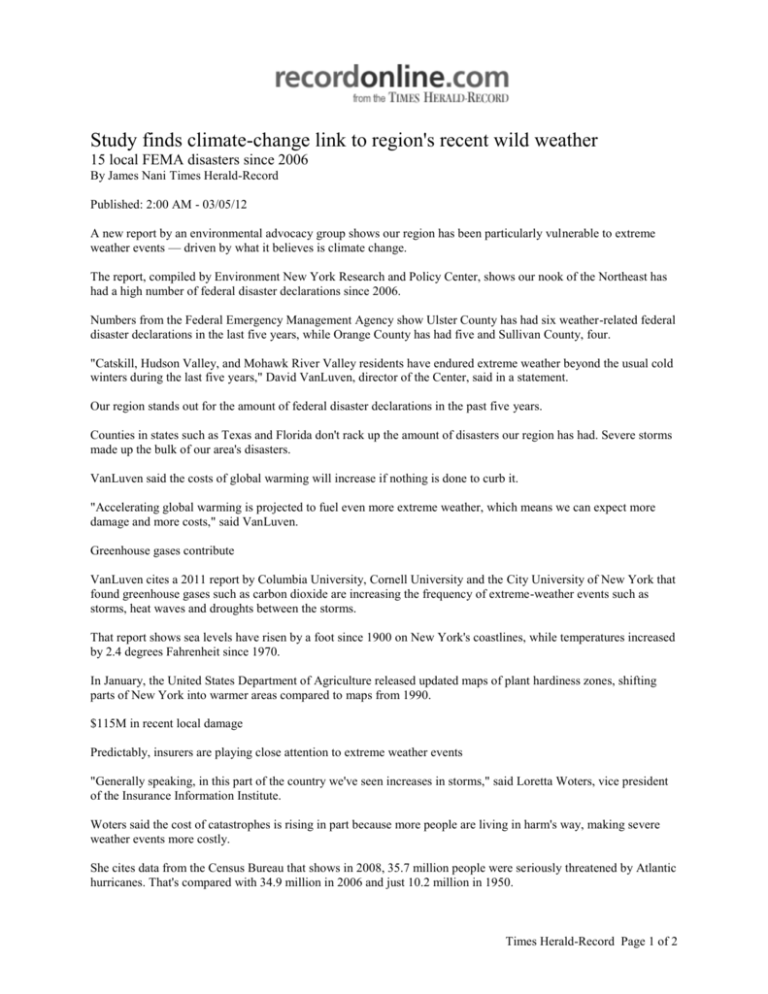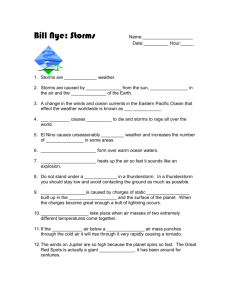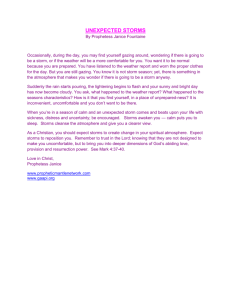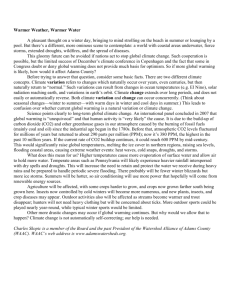Study finds climate change link to region s recent wild weather
advertisement

Study finds climate-change link to region's recent wild weather 15 local FEMA disasters since 2006 By James Nani Times Herald-Record Published: 2:00 AM - 03/05/12 A new report by an environmental advocacy group shows our region has been particularly vulnerable to extreme weather events — driven by what it believes is climate change. The report, compiled by Environment New York Research and Policy Center, shows our nook of the Northeast has had a high number of federal disaster declarations since 2006. Numbers from the Federal Emergency Management Agency show Ulster County has had six weather-related federal disaster declarations in the last five years, while Orange County has had five and Sullivan County, four. "Catskill, Hudson Valley, and Mohawk River Valley residents have endured extreme weather beyond the usual cold winters during the last five years," David VanLuven, director of the Center, said in a statement. Our region stands out for the amount of federal disaster declarations in the past five years. Counties in states such as Texas and Florida don't rack up the amount of disasters our region has had. Severe storms made up the bulk of our area's disasters. VanLuven said the costs of global warming will increase if nothing is done to curb it. "Accelerating global warming is projected to fuel even more extreme weather, which means we can expect more damage and more costs," said VanLuven. Greenhouse gases contribute VanLuven cites a 2011 report by Columbia University, Cornell University and the City University of New York that found greenhouse gases such as carbon dioxide are increasing the frequency of extreme-weather events such as storms, heat waves and droughts between the storms. That report shows sea levels have risen by a foot since 1900 on New York's coastlines, while temperatures increased by 2.4 degrees Fahrenheit since 1970. In January, the United States Department of Agriculture released updated maps of plant hardiness zones, shifting parts of New York into warmer areas compared to maps from 1990. $115M in recent local damage Predictably, insurers are playing close attention to extreme weather events "Generally speaking, in this part of the country we've seen increases in storms," said Loretta Woters, vice president of the Insurance Information Institute. Woters said the cost of catastrophes is rising in part because more people are living in harm's way, making severe weather events more costly. She cites data from the Census Bureau that shows in 2008, 35.7 million people were seriously threatened by Atlantic hurricanes. That's compared with 34.9 million in 2006 and just 10.2 million in 1950. Times Herald-Record Page 1 of 2 "In general, the cost of catastrophes is rising," said Woters. There's been an estimated $115 million in damage from summer storms in 2011 in Orange, Ulster and Sullivan counties — according to federal funds distributed or requested so far for repairs, and the estimated value of crops that perished in floodwaters. "In terms of extremes there's been more frequent and more extreme storms," Woters said. Bedrock also a factor Insured catastrophe losses in the United States totaled $35.9 billion in 2011, while the average from 2000 to 2010 was just $23.8 billion in 2011 dollars, according to the Insurance Information Institute. "More people are living in harm's way," said Woters. In February, New York began requiring companies writing more than $300 million in premiums to respond to a "climate-risk disclosure survey." The survey asks insurers to show how climate change affects their risk management and risk-modeling decisions. Russell Urban-Mead, senior hydrogeologist at The Chazen Companies said that, on top of extreme weather, our region is also vulnerable to flooding because of the underlying bedrock. Generally, shale bedrock in our region is "unfractured" which gives it little ability to store groundwater. Climate change and "human-caused" global warming have become controversial and polarizing issues. Patrick Gallagher of Gallagher Solar Thermal in Warwick said he's seen an increase in people buying solar panels. "People are concerned. They want to do what they can to reduce climate change," he said. Though Gallagher said he believes global warming is caused by man, he's reluctant to use the term because of the negative reaction it can garner. Regardless, he said, "Whether you believe in climate change or not, why would you want to put pollutants in the atmosphere?" More online The Responding to Climate Change in New York State report can be found on the New York State Energy Research and Development Authority (NYSERDA) at http://www.nyserda.ny.gov. The In the Path of the Storm report can be found at http://www.environmentamerica.org. Times Herald-Record Page 2 of 2







